A) 2 bolts and 2 nails and Azerbaijan gained 2 bolts and 18 nails.
B) 4 bolts and 2 nails and Azerbaijan gained 2 bolts and 14 nails.
C) 14 bolts and 38 nails and Azerbaijan gained 16 bolts and 42 nails.
D) 16 bolts and 38 nails and Azerbaijan gained 16 bolts and 38 nails.
Correct Answer

verified
Correct Answer
verified
Multiple Choice
Table 3-26
Assume that Japan and Korea can switch between producing cars and producing airplanes at a constant rate.
 -Refer to Table 3-26. Korea has an absolute advantage in the production of
-Refer to Table 3-26. Korea has an absolute advantage in the production of
A) cars and a comparative advantage in the production of cars.
B) cars and a comparative advantage in the production of airplanes.
C) neither good and a comparative advantage in the production of cars.
D) neither good and a comparative advantage in the production of airplanes.
Correct Answer

verified
Correct Answer
verified
Multiple Choice
Table 3-8
Assume that England and Spain can switch between producing cheese and producing bread at a constant rate.
 -Refer to Table 3-8. Which of the following combinations of cheese and bread could England not produce in 24 hours?
-Refer to Table 3-8. Which of the following combinations of cheese and bread could England not produce in 24 hours?
A) 5 units of cheese and 3 units of bread.
B) 6 units of cheese and 4 units of bread.
C) 8 units of cheese and 3 units of bread.
D) 7 units of cheese and 2 units of bread.
Correct Answer

verified
Correct Answer
verified
Multiple Choice
Table 3-6
Assume that Zimbabwe and Portugal can switch between producing toothbrushes and producing hairbrushes at a constant rate. 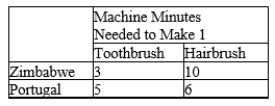 -Refer to Table 3-6. Which of the following represents Zimbabwe's and Portugal's production possibilities frontiers when each country has 60 minutes of machine time available?
-Refer to Table 3-6. Which of the following represents Zimbabwe's and Portugal's production possibilities frontiers when each country has 60 minutes of machine time available?
A) Zimbabwe Portugal ![]()
![]()
B) Zimbabwe Portugal ![]()
![]()
C) Zimbabwe Portugal ![]()
![]()
D) Zimbabwe Portugal ![]()
![]()
Correct Answer

verified
Correct Answer
verified
Multiple Choice
Table 3-10
Assume that Japan and Korea can switch between producing cars and producing airplanes at a constant rate.

-Refer to Table 3-10. Assume that Japan and Korea each has 2400 hours available. If each country divides its time equally between the production of cars and airplanes, then total production is
-Refer to Table 3-10. Assume that Japan and Korea each has 2400 hours available. If each country divides its time equally between the production of cars and airplanes, then total production is
A) 40 cars and 8 airplanes.
B) 64 cars and 16 airplanes.
C) 80 cars and 16 airplanes.
D) 128 cars and 32 airplanes.
Correct Answer

verified
Correct Answer
verified
Multiple Choice
Figure 3-18
Bintu's Production Possibilities Frontier
Juba's Production Possibilities Frontier 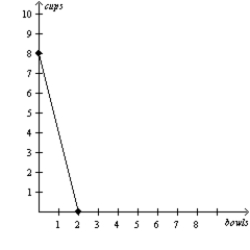
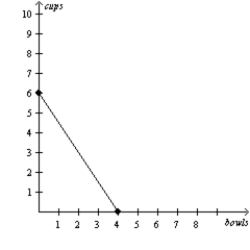 -Refer to Figure 3-18. If Bintu and Juba switch from each person dividing her time equally between the production of cups and bowls to each person spending all of her time producing the good in which she has a comparative advantage, then total production will increase by
-Refer to Figure 3-18. If Bintu and Juba switch from each person dividing her time equally between the production of cups and bowls to each person spending all of her time producing the good in which she has a comparative advantage, then total production will increase by
A) 1 bowl and 1 cup.
B) 2 bowls and 4 cups.
C) 3 bowls and 5 cups.
D) 4 bowls and 8 cups.
Correct Answer

verified
Correct Answer
verified
Multiple Choice
Table 3-25
Assume that Maya and Miguel can switch between producing mixers and producing toasters at a constant rate.
 -Refer to Table 3-25. Maya has an absolute advantage in the production of
-Refer to Table 3-25. Maya has an absolute advantage in the production of
A) both goods and a comparative advantage in the production of mixers.
B) both goods and a comparative advantage in the production of toasters.
C) neither good and a comparative advantage in the production of mixers.
D) neither good and a comparative advantage in the production of toasters.
Correct Answer

verified
A
Correct Answer
verified
Multiple Choice
Table 3-26
Assume that Japan and Korea can switch between producing cars and producing airplanes at a constant rate.
 -Refer to Table 3-26. Japan's opportunity cost of one airplane is
-Refer to Table 3-26. Japan's opportunity cost of one airplane is
A) 1/5 car and Korea's opportunity cost of one airplane is 1/3 car.
B) 1/5 car and Korea's opportunity cost of one airplane is 3 cars.
C) 5 cars and Korea's opportunity cost of one airplane is 1/3 car.
D) 5 cars and Korea's opportunity cost of one airplane is 3 cars.
Correct Answer

verified
Correct Answer
verified
Multiple Choice
Table 3-10
Assume that Japan and Korea can switch between producing cars and producing airplanes at a constant rate.

-Refer to Table 3-10. We could use the information in the table to draw a production possibilities frontier for Japan and a second production possibilities frontier for Korea. If we were to do this, measuring airplanes along the horizontal axis, then
-Refer to Table 3-10. We could use the information in the table to draw a production possibilities frontier for Japan and a second production possibilities frontier for Korea. If we were to do this, measuring airplanes along the horizontal axis, then
A) the slope of Japan's production possibilities frontier would be -5 and the slope of Korea's production possibilities frontier would be -3.
B) the slope of Japan's production possibilities frontier would be -0.2 and the slope of Korea's production possibilities frontier would be -0.33.
C) the slope of Japan's production possibilities frontier would be 0.2 and the slope of Korea's production possibilities frontier would be 0.33.
D) the slope of Japan's production possibilities frontier would be 5 and the slope of Korea's production possibilities frontier would be 3.
Correct Answer

verified
Correct Answer
verified
True/False
Fred trades 2 tomatoes to Barney in exchange for 1 pumpkin. Fred and Barney both gain from the exchange. We can conclude that, for Barney, the opportunity cost of producing 1 pumpkin is greater than 2 tomatoes.
Correct Answer

verified
False
Correct Answer
verified
Multiple Choice
Figure 3-21
Uzbekistan's Production Possibilities Frontier
Azerbaijan's Production Possibilities Frontier 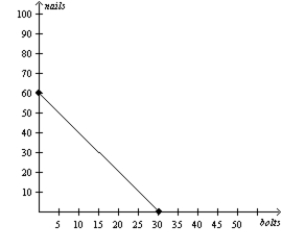
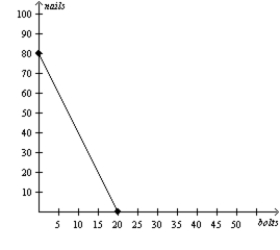 -Refer to Figure 3-21. If Uzbekistan and Azerbaijan each spends all its time producing the good in which it has a comparative advantage and trade takes place at a price of 12 bolts for 36 nails, then
-Refer to Figure 3-21. If Uzbekistan and Azerbaijan each spends all its time producing the good in which it has a comparative advantage and trade takes place at a price of 12 bolts for 36 nails, then
A) neither Uzbekistan nor Azerbaijan will gain from this trade.
B) Uzbekistan will gain from this trade, but Azerbaijan will not.
C) Azerbaijan will gain from this trade, but Uzbekistan will not.
D) both Uzbekistan and Azerbaijan will gain from this trade.
Correct Answer

verified
Correct Answer
verified
Multiple Choice
Table 3-36 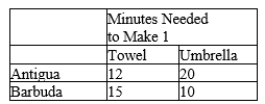 -Refer to Table 3-36. What is Barbuda's opportunity cost of one umbrella?
-Refer to Table 3-36. What is Barbuda's opportunity cost of one umbrella?
A) 3/5 towels
B) 2/3 towels
C) 3/2 towels
D) 5/3 towels
Correct Answer

verified
Correct Answer
verified
Multiple Choice
Table 3-25
Assume that Maya and Miguel can switch between producing mixers and producing toasters at a constant rate.
 -Refer to Table 3-25. The opportunity cost of 1 toaster for Maya is
-Refer to Table 3-25. The opportunity cost of 1 toaster for Maya is
A) 0.625 mixers.
B) 1.6 hours of labor.
C) 1.6 mixers.
D) 8 hours of labor.
Correct Answer

verified
Correct Answer
verified
Multiple Choice
An economy's production possibilities frontier is also its consumption possibilities frontier
A) under all circumstances.
B) under no circumstances.
C) when the economy is self-sufficient.
D) when the rate of tradeoff between the two goods being produced is constant.
Correct Answer

verified
Correct Answer
verified
Multiple Choice
Total output in an economy increases when each person specializes because
A) there is less competition for the same resources.
B) each person spends more time producing that product in which he or she has a comparative advantage.
C) a wider variety of products will be produced within each country due to specialization.
D) government necessarily plays a larger role in the economy due to specialization.
Correct Answer

verified
Correct Answer
verified
Multiple Choice
Table 3-29
Juanita and Shantala run a business that programs and tests cellular phones. Assume that Juanita and Shantala can switch between programming and testing cellular phones at a constant rate. The following table applies.
 -Refer to Table 3-29. Shantala has an absolute advantage in
-Refer to Table 3-29. Shantala has an absolute advantage in
A) programming cellular phones and a comparative advantage in programming cellular phones.
B) programming cellular phones and a comparative advantage in testing cellular phones.
C) testing cellular phones and a comparative advantage in programming cellular phones.
D) testing cellular phones and a comparative advantage in testing cellular phones.
Correct Answer

verified
Correct Answer
verified
Multiple Choice
Figure 3-5
Hosne's Production Possibilities Frontier
Merve's Production Possibilities Frontier 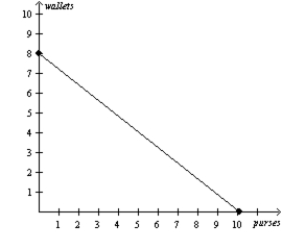
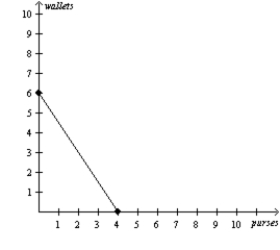 -Refer to Figure 3-5. If Hosne must work 0.5 hour to make each purse, then her production possibilities frontier is based on how many hours of work?
-Refer to Figure 3-5. If Hosne must work 0.5 hour to make each purse, then her production possibilities frontier is based on how many hours of work?
A) 2 hours
B) 5 hours
C) 20 hours
D) 50 hours
Correct Answer

verified
Correct Answer
verified
Multiple Choice
Table 3-28
Barb and Jim run a business that sets up and tests computers. Assume that Barb and Jim can switch between setting up and testing computers at a constant rate. The following table applies.
 -Refer to Table 3-28. Barb's opportunity cost of testing one computer is setting up
-Refer to Table 3-28. Barb's opportunity cost of testing one computer is setting up
A) 4/5 computer and Jim's opportunity cost of testing one computer is setting up 3/4 computer.
B) 4/5 computer and Jim's opportunity cost of testing one computer is setting up 4/3 computers.
C) 5/4 computers and Jim's opportunity cost of testing one computer is setting up 3/4 computer.
D) 5/4 computers and Jim's opportunity cost of testing one computer is setting up 4/3 computers.
Correct Answer

verified
Correct Answer
verified
Multiple Choice
Figure 3-14
Arturo's Production Possibilities Frontier
Dina's Production Possibilities Frontier 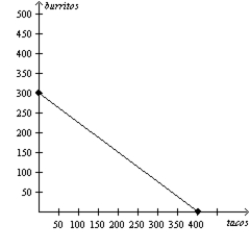
 -Refer to Figure 3-14. Arturo and Dina would not be able to gain from trade if Dina's opportunity cost of one taco changed to
-Refer to Figure 3-14. Arturo and Dina would not be able to gain from trade if Dina's opportunity cost of one taco changed to
A) 1/2 burrito.
B) 3/4 burrito.
C) 4/3 burritos.
D) 2 burritos.
Correct Answer

verified
Correct Answer
verified
Multiple Choice
Figure 3-18
Bintu's Production Possibilities Frontier
Juba's Production Possibilities Frontier 
 -Refer to Figure 3-18. Bintu has an absolute advantage in the production of
-Refer to Figure 3-18. Bintu has an absolute advantage in the production of
A) bowls and Juba has an absolute advantage in the production of cups.
B) cups and Juba has an absolute advantage in the production of bowls.
C) both goods and Juba has an absolute advantage in the production of neither good.
D) neither good and Juba has an absolute advantage in the production of both goods.
Correct Answer

verified
B
Correct Answer
verified
Showing 1 - 20 of 547
Related Exams